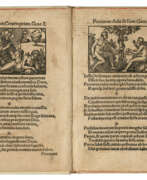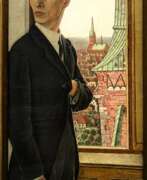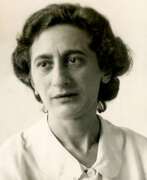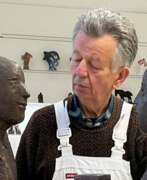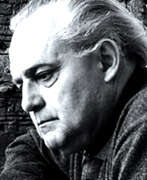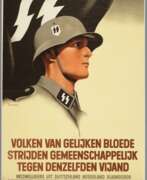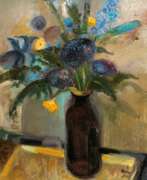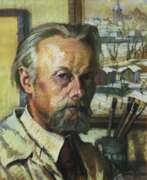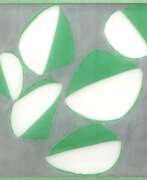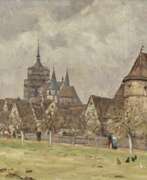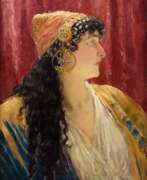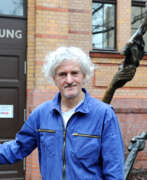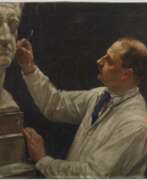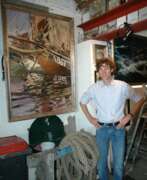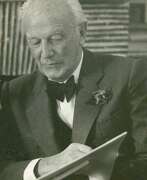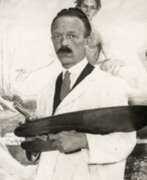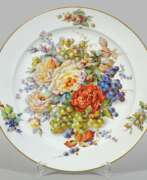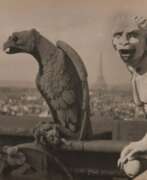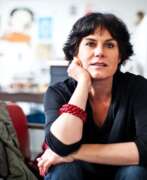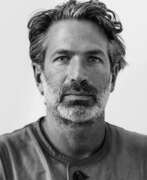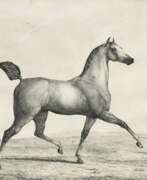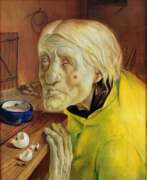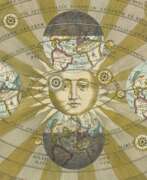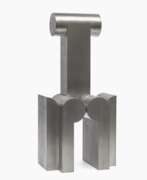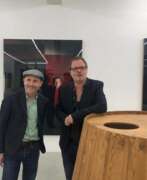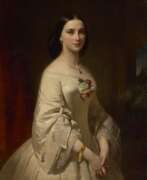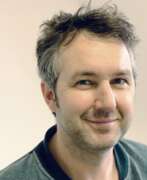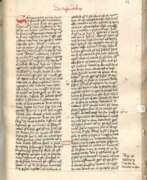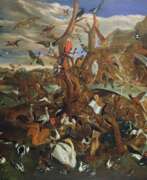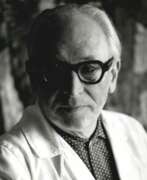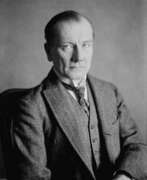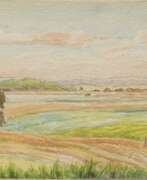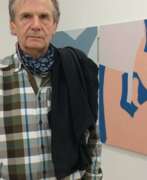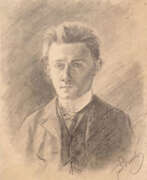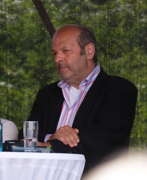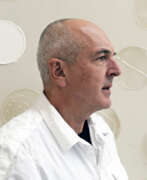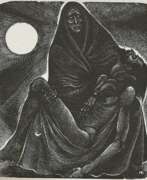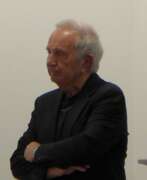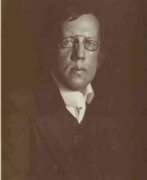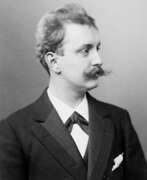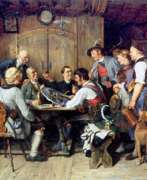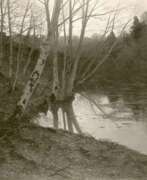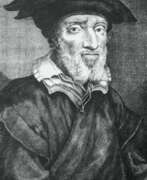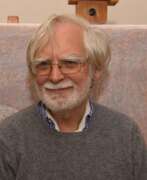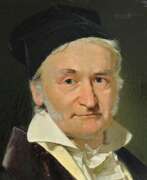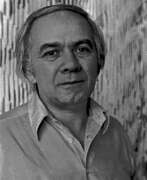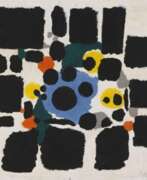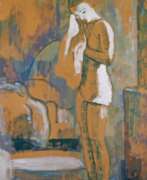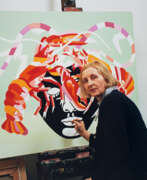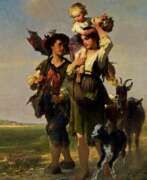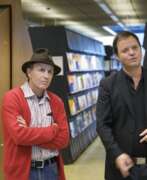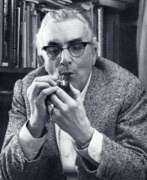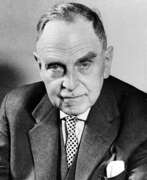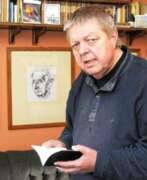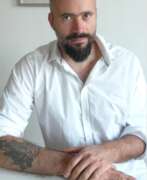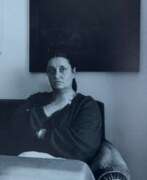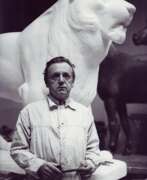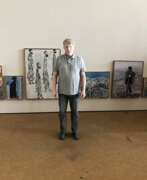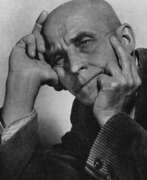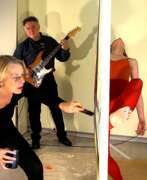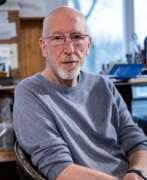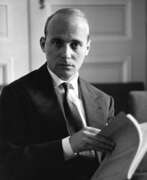Educators Germany


Josef Albers was a German-born artist and educator. The first living artist to be given a solo shows at MoMA and at the Metropolitan Museum of Art in New York, he taught at the Bauhaus and Black Mountain College, headed Yale University's department of design, and is considered one of the most influential teachers of the visual arts in the twentieth century.
As an artist, Albers worked in several disciplines, including photography, typography, murals and printmaking. He is best known for his work as an abstract painter and a theorist. His book Interaction of Color was published in 1963.
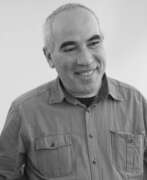

Yuri Albert is a contemporary Russian artist, art theorist and educator; a member of the Moscow conceptualist circle. He currently lives and works in Moscow and Cologne.
Yuri Albert's works are in the collections of major Russian and international institutions.
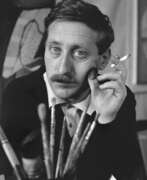

Horst Antes was a German painter, graphic artist and sculptor, a pioneer of the new figurative painting in Germany.
After studying at the Karlsruhe Academy of Fine Arts from 1957 to 1959, Antes taught there himself and later became a professor there.
Antes became known for the Kopffüßler (head-foot) image, which has been a recurring theme in his paintings, sculptures and graphic works since the early 1960s. Antes' work is represented in several major collections in Berlin, Hamburg, Cologne and elsewhere in Germany.
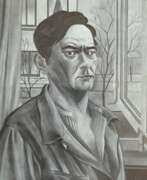

Christian Arnold was a German painter and graphic artist. He is best known for his landscape paintings that often depicted the rural and coastal regions of northern Germany.
Arnold studied at the Academy of Fine Arts in Munich and later taught at the School of Arts and Crafts in Bremen. His work was heavily influenced by the German Expressionist movement, and he often used bold colors and thick brushstrokes to create a sense of emotional intensity in his paintings.
In addition to his landscapes, Arnold also produced numerous portraits, still lifes, and religious works. He worked in a variety of mediums, including oil paints, watercolors, and printmaking.
Arnold's work was exhibited widely during his lifetime, and he received numerous awards and honors for his contributions to the arts. Today, his paintings are held in collections around the world, including the National Gallery in Berlin and the Kunsthalle Bremen.
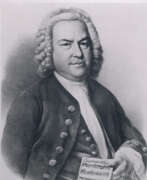

Johann Sebastian Bach was a German Baroque composer, Kapellmeister, organist and teacher.
Johann Sebastian Bach was the youngest child in the family of musician Johann Ambrosius Bach (1645-1695) and belonged to a large family of North German musicians whose dynasty he himself traced back to his great-great-grandfather Veit Bach, a Lutheran baker in the late 16th century. Johann was orphaned at an early age and was taken into care by his older brother, the organist Johann Christoph Bach. In August 1703 he was appointed official organist of the church in Arnstadt, then from 1714 he worked as Kapellmeister and concertmaster at the Weimar court, to which time his first compositions date. In 1736 he was appointed court composer to the King of Saxony, thus recognizing his merits as a composer and organist. While working as a concertmaster, Bach also mastered almost all the instruments in the orchestra.
In the last years of his life, Bach was nearly blind and living poorly, and his Baroque music was considered outdated as tastes changed. But in the 19th century, interest in Bach's works increased dramatically, and he became the favorite composer of many subsequent musicians. Johann Sebastian's sons Wilhelm Friedemann, Carl Philipp Emanuel and Johann Christian continued the family dynasty and also became musicians. And Johann Sebastian Bach himself was surrounded by students throughout his life.
Although his contemporaries admired Bach's playing on the harpsichord and organ, today it is his compositions that are considered some of the finest works of mature Baroque music. His most widely known works today include the Brandenburg Concertos, the Well-Tempered Clavier, the Masses in B minor, and many other masterpieces of church and instrumental music. Bach's rich legacy includes sacred and secular compositions, especially cantatas, organ pieces and concertos (Bach composed more than 1,000 musical works in all significant genres of his time, except opera), which influenced many later composers. Johann Sebastian Bach was able to encompass and unite the major styles, forms and national traditions developed in previous generations. Today he is considered one of the greatest composers of all time.
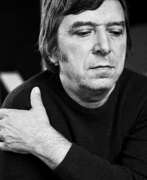

Hermann Bachmann is a German artist, graphic designer and teacher.
Hermann studied at the School of Applied Arts Offenbach am Main and served in the army during World War II. In 1945, Bachmann returned to his hometown and joined the artists of the Halle School. And in 1953 he fled to West Berlin, whose creative atmosphere was closer to him.
In 1957 Hermann Bachmann became a teacher and later a professor at the University of Fine Arts in Berlin, among his students many famous artists. He was a member of the Association of German Artists.
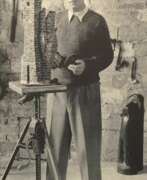

Otto Baum is a German sculptor and university lecturer and member of the German Artists' Association.
He studied painting at the Stuttgart Academy of Art and sculpture at the same time. From the mid-1930s, the National Socialists who came to power in Germany forbade Baum to exhibit or even work, and he was persecuted as a representative of "degenerate art".
After the war, Otto Baum was appointed to teach at the Stuttgart Academy of Art and was regarded as the most progressive and extremely critical teacher among the young students at the academy.
Otto Baum is considered one of the most important representatives of classical modernism, who had a significant influence on European sculpture in the second half of the 20th century both through his work and as a teacher.
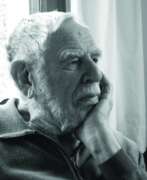

Moritz Baumgartl is a German painter, graphic artist and university professor living in Stuttgart.
Moritz studied at the Stuttgart State Academy of Fine Arts and worked for a long time as an art teacher at the Friedrich Eugens Gymnasium in Stuttgart. Baumgartl founded the art group "Stuttgart School" together with the artists Axel Arndt and Adam Lüde Döring.
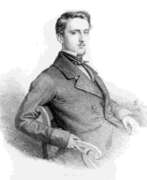

Hiob Carl Oscar Begas was a German painter of the mid-nineteenth century. He is known as a portraitist, landscape painter, historian, teacher, son of the painter Carl Begas, brother of the sculptors and painters Carl, Rheingold and Adalbert Begas.
Oscar Begas was the author of portraits of many prominent German and foreign statesmen and military figures, representatives of science and culture. Becoming a popular painter, he received many orders from King Friedrich Wilhelm IV of Prussia. According to critics, more than in commissioned portraits, Begas's painterly skill was demonstrated in his atmospheric winter and autumn landscapes, on which the master concentrated towards the end of his life.
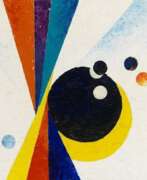

Joseph Binder, full name Joseph Friedrich Gustav Binder, was a German avant-garde painter, designer and graphic artist.
In the early 1930s, Joseph Binder worked on major brand commissions for Knorr, Reemtsma, Tekrum, Elida, Minera, Dujardin, Stella and Mercedes-Benz and earned fame as a style-defining industrial designer. In all, by the early 1960s, Binder had created more than 2,000 stamps and posters.
In painting, Binder favored cubism: geometrically stylized form is of great importance to the painter. He was also influenced by the Bauhaus school of art and the Blue Rider group.


Andreas Böhm is a German painter, graphic artist and art teacher at Brunsbüttel Upper Secondary School from 1980. He lives and works in Dingen, Schleswig-Holstein.
For a long time Andreas Bem was known for his stencil drawings, which are like silhouettes with just two or three thick layers of paint. As an artist, he continued to play with shapes, but now adapted the free lines of wildlife.
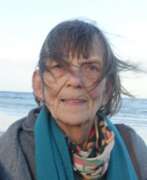

Erdmut Bramke is a contemporary German artist. She was a guest professor at the Stuttgart State Academy of Fine Arts. She has documented 600 paintings, 1500 works on paper, 80 solo exhibitions, 200 group exhibitions and the artistic decoration of numerous public buildings. Erdmut Bramke consistently represents concrete art. Her concern is the purification of art to a pure return to colour and form, structure and rhythm. In her work she strives for law, harmony and order, real content is not her subject.
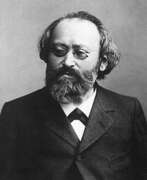

Max Bruch, full name Max Christian Friedrich Bruch, was a German composer and conductor, violinist and teacher of the late Romantic period.
Bruch studied with the composer and pianist Ferdinand Hiller (1853-1857), wrote a symphony at age 14, and won a scholarship that allowed him to study in Cologne. His first opera, Joke, Deceit and Revenge, was performed in 1858. He conducted orchestral and choral societies in Germany, England and Poland, and from 1890 to 1911 he was a professor at the Berlin Academy of Arts.
Bruch was an ambitious and prolific composer. His greatest success during his lifetime was his huge works for chorus and orchestra, Beautiful Ellen (1867) and Odysseus (1872). He was also the author of string concertos and pieces for violin and orchestra. His Violin Concerto No. 1 in G minor (1866) is one of the most popular Romantic violin concertos.
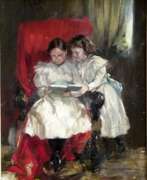

Ferdinand Brütt, full name Ferdinand Martin Cordt Brütt, was a German Impressionist painter.
Brütt began his studies at the Hamburg School of Applied Arts, then continued at the Art School of the Grand Duke of Saxony in Weimar before embarking on an extended study trip to Italy. For many years he lived in the Kronberg artists' colony in Kronberg im Taunus.
Brütt painted more often scenes from public places, particularly court sessions, domestic genre subjects and landscapes. From 1906 to 1913 he created several large wall and ceiling murals for the city of Frankfurt. In 1905 he was commissioned to design a large public hall in the town hall of Frankfurt am Main.
Ferdinand Brütt also taught at the Academy of Arts Düsseldorf, was a member of the Association of German Artists and was a member of the Association of Artists of Malkasten.


Daniele Buetti is a Swiss visual artist who works in several modes including installation and intervention. The media he works with includes photography, sculpture, drawing, sound, video and digital forms. He is professor at University of Fine Arts Munster where he has taught since 2004. He lives and works in Zurich, Switzerland and Münster, Germany.
His work has been described as "an expression of world-weariness and the individual’s precarious existential orientation." In the 1990s Buetti's work served as a visual critiques of the consumption of beauty. This work often appropriated images of models and high-fashion consumer products from magazines that were pierced with a ballpoint pen.
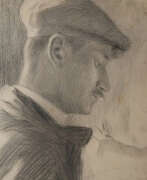

Georg Burmester was a German artist of the late 19th - first third of the 20th centuries. He is known as a painter, graphic artist, impressionist, representative of the Düsseldorf art school, and teacher.
Burmester worked mainly in the genres of landscape and marinas, but among his works there are also still lifes, as well as works in the genre of nude. He was a teacher at the Kassel Art School from 1912 to 1930 and was promoted to the rank of professor in 1917.
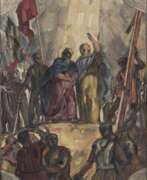

Karl Caspar was a German painter and graphic artist.
Caspar studied at the Art Academy in Stuttgart and the Academy of Fine Arts in Munich. In 1904 he became a member of the Stuttgart Artists' Union (Stuttgarter Künstlerbund), in 1906 he joined the German Artists' Union (Deutscher Künstlerbund). In 1913 he became one of the founders of the New Munich Secession, becoming its chairman in 1919.
Karl Caspar's creative field was painting and drawing with Impressionist and Expressionist influences in various genres, from Christian subjects to the nude genre.
From 1922 to 1937, Karl Caspar was professor and then president of the Academy of Fine Arts in Munich. In 1937, his works were exhibited at the Exhibition of Degenerate Art organized by the Nazis in Munich, but many of them were then withdrawn from German museums and state collections and destroyed. After the end of World War II, Karl Caspar returned to teaching: in 1948 he became one of the founders of the Bavarian Academy of Fine Arts, and in 1955 he became an academician of the Berlin Academy of Arts. He participated in the Venice Biennale and was awarded the Order of Merit of the Federal Republic of Germany in 1950.


Fritz Cremer was a German sculptor, graphic artist, and teacher, renowned for his powerful memorials commemorating the victims of fascism, particularly those in concentration camps like Buchenwald, Ravensbrück, and Mauthausen. Born in Arnsberg an der Ruhr in 1906, Cremer's journey into the arts began with an apprenticeship to a marble maker, followed by formal education at the Higher School of Fine Arts in Charlottenburg. His early engagement with the Communist Party in 1929 marked the start of a lifelong commitment to anti-fascist and political themes in his work.
Cremer's works defy easy categorization. They span a broad range of subjects, from the deeply political to the profoundly personal, including acts and lovers that express erotic sensuality and tenderness. His style, neither fully modern nor socialist realist, aimed at capturing the "mentalic constitution" of his subjects, often emphasizing their physical irregularities to break from idealized representations. Cremer's most notable works include the Buchenwald Monument and "O Deutschland, bleiche Mutter" at Mauthausen, as well as other significant memorials across Germany, Austria, and the USA.
Throughout his career, Cremer was celebrated for his contributions to art and society, receiving accolades such as an invitation to documenta 6 in 1977 and the Stiftung Bremer Sculptor’s Prize in 1992. He passed away in Berlin in 1993, leaving behind a legacy that continues to be studied and admired.
For collectors and experts in art and antiques, Fritz Cremer's works offer a profound exploration of human resilience, suffering, and solidarity. His memorials serve as powerful reminders of history's darkest chapters and the enduring spirit of those who resist oppression. To stay informed about exhibitions and auctions featuring Fritz Cremer's works, sign up for updates and ensure you don't miss the opportunity to engage with the legacy of this pivotal artist.
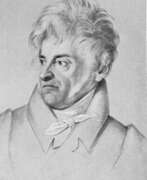

Joseph Wilhelm Eduard d'Alton was a German engraver, naturalist and educator.
He had an initial military education and later studied art and natural history while traveling in Italy and France. Eduard d'Alton is widely known for his anatomical and zoological engravings and etchings. In 1818, d'Alton was appointed professor of natural history at the University of Bonn, where he later began to teach art history as well. Among his students was Karl Marx.
D'Alton's son Johann Samuel Eduard d'Alton (1803-1854), professor of anatomy, continued his father's unfinished Osteologie (Bonn, 1827-1838) and published the first volume of the Handbook of Comparative Human Anatomy.
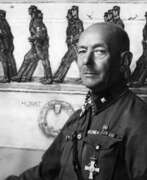

Ludwig Julius Christian Dettmann was a German artist of the late 19th century and the first half of the 20th century. He is known as one of the leading representatives of the Secession in Germany.
Dettmann began his career as an illustrator and in 1895 became a professor at the Berlin Academy of Arts. He then switched to landscape painting, worked in oil and watercolor techniques and became one of the first Impressionists in Germany. In 1898 the artist joined the Association of German Free Artists and co-founded the Berlin Secession. In 1900 Dettmann became director of the Königsberg Academy of Arts and promoted the development of the Nida colony of landscape artists on the Curonian Spit.
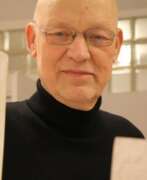

Ludwig Dinnendahl was a German sculptor and teacher.
He studied at the colleges of fine arts in Frankfurt and Pforzheim. In his sculptures Ludwig Dinnendahl focuses on clear geometric forms, he used bronze or cast iron, stone and plaster as well as wood as materials. His works are represented in the public spaces of many cities and towns in the country.
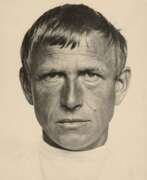

Wilhelm Heinrich Otto Dix was a German artist whose work stands as a stark, unyielding reflection of the societal tumult and trauma of the early 20th century. Born in 1891 in Untermhaus, Germany, Dix's early life was steeped in the arts, his ambition to become an artist nurtured by both familial influence and formal education in Dresden. His experiences as a soldier in World War I deeply influenced his artistic direction, leading him to vividly depict the horrors of war and the decay of the Weimar Republic with a brutal realism that became his signature style.
Dix's association with the Dada movement and the New Objectivity (Neue Sachlichkeit) further honed his critical, often cynical portrayal of post-war society. His works, such as "The Trench" and "War Cripples," expose the visceral aftermath of conflict, while his engagement with the Dadaists imbued his art with a disruptive, confrontational energy against societal norms and the art establishment.
Perhaps most notable is Dix's ability to capture the psychological depth and societal critiques through his portraits and landscapes, which ranged from the grotesque to the surreal. Paintings like "Portrait of the Journalist Sylvia von Harden" and the triptychs "Metropolis" and "War" are emblematic of his keen observation and stark depiction of the era's social and political unrest.
Despite facing significant adversity, including being labeled a degenerate artist by the Nazi regime and facing professional and personal setbacks, Dix's legacy as a painter and printmaker endures. His works are not only historical documents but also profound reflections on humanity, war, and society, resonating with collectors and art experts alike.
For enthusiasts of culture, art, and history, Dix's oeuvre offers an unflinching look into the human condition under the strain of societal and political upheaval. His contributions to painting and printmaking continue to be celebrated in museums and galleries worldwide, underscoring the enduring relevance of his work.
For those interested in exploring the profound depth and historical significance of Otto Dix's work, signing up for updates on new product sales and auction events related to his art can provide invaluable insights. This subscription is a gateway to staying informed about opportunities to engage with the tangible pieces of Dix's enduring legacy.
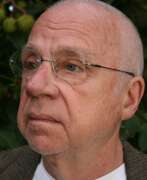

Peter Dreher was a German artist and academic teacher. He painted series of landscapes, interiors, flowers and skulls, beginning his series Tag um Tag guter Tag in 1974. As a professor of painting, he influenced artists including Anselm Kiefer. His works have been exhibited internationally.
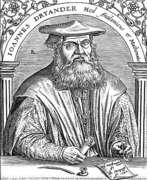

Johann Dryander, born Johann Eichmann, was a German medical anatomist, mathematician and astrologer.
He studied anatomy and medicine at the University of Paris and the University of Erfurt, and in 1535 became professor of medicine at the University of Marburg. A year later, Dryander performed two public autopsies, making the first illustrated description of the dissection of the human brain. Dryander titled his book Anatomiae, hoc est, corporis humani dissectionis pars prior ("Anatomy, that is, the dissection of the human body, part one," suggesting a sequel, which, however, did not follow.
His work made a significant contribution to the development of modern anatomy. Toward the end of his life, Dryander also dabbled in astrology and mathematics.


Thomas Duttenhoefer was a German sculptor, draughtsman, graphic artist, and illustrator, and professor at the University of Mannheim.
In addition to his human figures, Thomas Duttenhoefer's figurative work includes many depictions of animals in a deliberately crude manner.
He is a member of the New Darmstadt Secession, the Palatinate Secession and the Argo Group, Speyer.
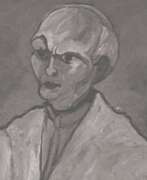

Heinrich Ehmsen was a German expressionist painter and graphic artist.
Coming from a poor family, Ehmsen studied at the School of Arts and Crafts in Düsseldorf, worked as a decorator and painted. Gradually, revolution became the central idea of many of his paintings. After World War I, in which he participated as a mobilized man, his reflections on the war and the failed German revolution lead him to the realization that human existence is threatened. All this is reflected in his drawings and paintings.
After a six-month internship in the south of France in 1929 Emzen moved to Berlin, and 1932-1933 years the artist spent in the USSR. His works were exhibited in Moscow, and Soviet museums acquired his paintings. With the National Socialists coming to power in Germany in 1937, Heinrich Ehmsen was condemned as a degenerate artist, and his paintings were withdrawn from German collections.
After the war, Heinrich Ehmsen worked as deputy director and head of the painting class at the Academy of Fine Arts in West Berlin, but in 1950 he moved to the Academy of Fine Arts in East Berlin. In 1961, the artist won the GDR National Prize.
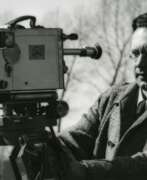

Alfred Ehrhardt was a universally talented German artist. He was an organist and choirmaster, then a music and art teacher in a remedial school, and finally an art teacher and painter, before becoming a photographer and director.
After spending the winter semester 1928-29 at the Bauhaus Dessau, where he was decisively influenced by Josef Albers, Wassily Kandinsky, Paul Klee and Oskar Schlemmer, he transferred the Bauhaus pre-course concept to his art lessons with children and young people, beginning in first grade and continuing through Abitur. Based on this experimental experience, in 1930 he was appointed to the Landeskunstschule Hamburg, where he created the first preliminary course in materials science outside the Bauhaus. After being dismissed by the National Socialists from the university in 1933 because of his modernist views of art, he turned to photography and film.
Alfred Ehrhardt is considered an outstanding representative of the new objective photography. After publishing more than 20 photobooks, he became one of the most successful photographers among the former Bauhaus artists. His "absolutely artistic films", which defy modernity and are inspired by the avant-garde of the 1920s, place him among the old masters of cultural and documentary cinema. Alfred Erhardt is considered "Germany's most important post-war creator of cultural films" and has received numerous national and international awards for his more than 50 films, including four Federal Film Prizes.
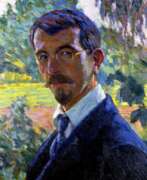

Wilhelm Heinrich Ernst Eitner was a German painter of the late nineteenth and first half of the twentieth centuries. He is known as an impressionist painter and teacher.
Eitner produced portraits, landscapes, and woodcuts in a style reminiscent of Japanese art. Despite initial rejection in German society of his impressionist style of painting, over the years he gained recognition and even the title "Claude Monet of the North." Eitner was a member of numerous art associations. His works are preserved in the Hamburg Kunsthalle.
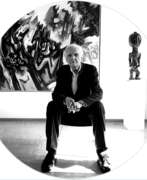

Gerhard Fietz was a German painter, professor and representative of non-objective painting. He is considered an important painter of the second half of the 20th century in Germany.
As a co-founder of the artist group ZEN 49, he opposed traditional representational art and, together with painters such as Willi Baumeister, Fritz Winter and Rupprecht Geiger, developed a style of painting that focused on experimenting with artistic means. Fietz exhibited at numerous national and international exhibitions, including the highly regarded exhibition at the Cercle Volnay in Paris in 1955.
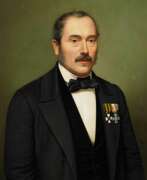

Jean-Baptiste Fresez was a German painter of French origin.
He began his studies at the Luxembourg School of Drawing and then continued at the Royal Academy in Brussels and obtained Luxembourg citizenship. Fresez worked as an engraver and painter at the Villeroy and Boch porcelain factory in Mettlach on the Saar River, and from 1824 he successfully taught at the Luxembourg Drawing School.
Fresez produced beautiful landscapes and very lively portraits. These are mainly of members of the Grand Ducal family and other well-known local personalities. A collection of 30 lithographs was published based on his landscape drawings, which today are considered very valuable in documentary terms, and each of them has a detailed description. Fresez's landscapes are characterized by their almost photographic depictions of the city of Luxembourg. After the publication of this work, he was elected a member of the Archaeological Society of the Grand Duchy.
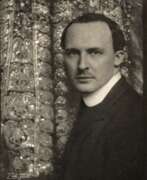

Willi Geiger was a German artist of the twentieth century. He is known as a painter, graphic artist, illustrator, exlibrist and teacher, a representative of Expressionism.
From the beginning of his career, Geiger created illustrations for the works of famous authors. In later years he became interested in portrait painting, painting copies of works by Spanish masters, especially El Greco, Velázquez and Goya. Geiger was one of the first modern graphic designers. His son Ruprecht Geiger also became a renowned painter and sculptor.
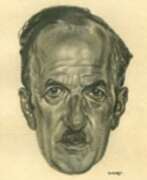

Hermann Gradl was a German artist of the first half of the twentieth century. He is known as a painter, graphic artist, illustrator and teacher, professor of art.
Hermann Gradl took up painting at the age of 25. He was self-taught, learning from the works of the masters of the Old German and Dutch schools, as well as the romanticized realists of the 19th century. The artist created small- and medium-format idyllic landscapes, urban vistas, and genre scenes. The rise to power in Germany of the National Socialists strengthened Gradl's position, as his work conformed to the cultural policies of the Third Reich. Hitler celebrated him as the best contemporary German landscape painter.
In all, Gradl created more than 8,000 drawings, some 2,100 oil paintings and hundreds of illustrations during his career.


Josef Grassi was an Austrian portrait and history painter. His middle name is usually given as "Maria", although there is evidence that it was actually "Mathias". He is also called "Giuseppe Grassi".
Grassi is best known for his sensitive portraits of women. In his later years, his style became less graceful and settled into a form of academic classicism.


Otto Griebel was a German artist of the twentieth century. He is known as a painter and graphic artist who worked in the directions of "new subject matter" and socialist realism.
Griebel joined the Dadaists after World War I and was a member of the Dresden Dadaist group. He participated in various artistic associations, including the Dresden Secession Group, the Aktion group of artists, the Association of Free Artists of Saxony, and others. In 1933, the artist was arrested by the Gestapo and his work was recognized as "degenerate art". Most of the master's work was lost during the bombing of Dresden in 1945.
Griebel was also a talented puppet theater artist and created sets for puppet shows.


Christian Griepenkerl was an Austro-German painter of the last third of the 19th and early 20th centuries. He is known as a painter and teacher, a professor at the Vienna Academy of Fine Arts.
Griepenkerl created many paintings of historical subjects and themes from ancient mythology, and was also a successful portraitist. As a teacher, he was famous for having twice prevented the young Adolf Hitler from taking the entrance examinations to the Vienna Academy of Fine Arts.
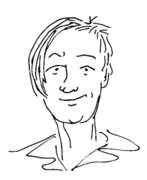

Friederike Groß is a German painter, caricaturist and university teacher who lives and works as a freelance artist in Stuttgart.
Friederike Groß studied free graphics and art education with Dieter Groß at the State Academy of Fine Arts Stuttgart from 1984 to 1989. Since 1985, Friederike Groß has worked as a caricaturist for the Stuttgarter Zeitung.
From 2008 to 2014, Friederike Groß taught as a lecturer in drawing at the Swiss Federal Institute of Technology (ETH) in Zurich. Since 2013, she has held a professorship for illustration at the Berlin Technical University of the Arts (BTK) at the campus in Hamburg.
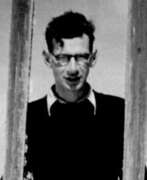

Rudolf Grossmann (German: Rudolf Grossmann, or Großmann), full name Rudolf Wilhelm Walther Grossmann, was a German painter, draftsman, illustrator and graphic artist.
Born into an artistic family, Grossmann began his education in painting and printmaking at the Düsseldorf Academy before continuing his studies in Paris with Lucien Simon and Pouleroz. Among his best-known works are various portrait drawings of celebrities, notably those published in the satirical periodical Simplicissimus; he was also known for his book illustrations. Grossmann began publishing his prints in 1905, and many major publishers in Germany and France commissioned his work. He later concentrated on figurative works and urban scenes, which showed the influence of Cézanne and Pasquin.
From 1928 until Hitler's Nazi Party came to power, Grossmann taught at the Berlin Royal School of Art and was a member of the Berlin Secession and the Deutsche Kunstlerbund. In 1934, his work, like that of many of his colleagues, was stigmatized as degenerate and confiscated by the Nazi government, and he was disbarred from practicing his profession. He soon left for Freiberg im Beisgau, where he died on November 28, 1941.
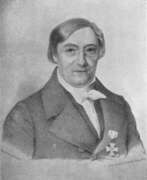

Johann Gottfried Gruber was a German critic and literary historian.
A graduate of the University of Leipzig, Gruber was later appointed professor at the University of Wittenberg, and in 1815 he became professor of philosophy at Halle. Gruber is the author of numerous historical and philosophical works.
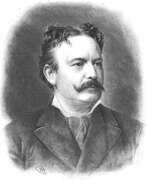

Karl Gussow or Carl Gussow was a German realist painter of the 19th century.
Gussow began his painting studies at the Saxon Art School in Weimar and traveled to Italy. He later worked with the Belgian painter-historian Ferdinand Pauwels, who greatly influenced his style.
Gussow was active as a genre and portrait painter. Over time, his work became characterized by an almost photographic realism, which was not only admired but also criticized, as it was a completely new direction.
Karl Gussow lived in Karlsruhe and Berlin, where he maintained a private ladies' studio, later founding another private painting school. He obtained a position at the Karlsruhe Academy of Fine Arts, also worked at the Prussian Academy of Fine Arts and taught at the Munich Academy of Fine Arts.
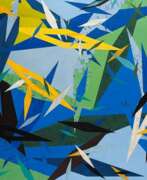

Dieter Haack is a German abstractionist painter.
Dieter Haack studied painting at the Düsseldorf Academy of Fine Arts. His works are characterised by bold colours and energetic compositions.
In addition to his art practice, Haack also worked as a professor of painting and drawing at his alma mater.


Ulrich Hachulla is a German painter and graphic artist, representative of the New Objectivity movement, who lives and works in Leipzig.
He was educated at the Academy of Fine Arts in Leipzig and, in addition to painting, has mastered many graphic techniques.
Hahulla's portraits and self-portraits depict a man in solitude, unsociable, coldly detached - these are numerous types of the respective times. The artist also creates paintings with mythological and allegorical references.


Maximilian Joseph Haushofer was a German painter of the mid-nineteenth century. He is known as a landscape painter and teacher, professor of painting at the Prague Academy of Fine Arts.
Born into the family of a teacher at the court of the Bavarian king, Haushofer began to study law, but soon indulged himself in art. His favorite subjects for a long time were the Alpine foothills and lakes illuminated by the midday sun. His students continued the tradition of his school, making Haushofer a prominent figure in the art world.
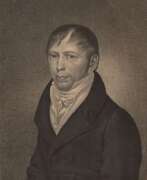

Friedrich Gottlob Hayne was a German botanist, taxonomist, pharmacist and professor.
After many years of teaching, he was appointed Professor of Pharmaceutical Botany in 1828. In addition to his lecturing duties he led many botanical excursions. He was known for using precise terminology in his plant descriptions.
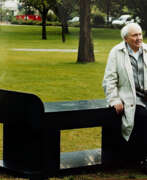

Erwin Heerich was a German artist.
Heerich emphasized that for him, "cardboard, like polystyrene, had no specifically aesthetic or historical connotations, the materials are value-neutral to the largest possible extent." Furthermore, the artist was not primarily "concerned with the manifestation of an art object, but with making an idea material in terms of a specific problem: how space can be presented and formed."
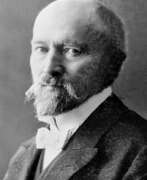

Johann Caspar Herterich was a German painter of the last third of the nineteenth century. He is known as a historical and genre painter, as well as a teacher at the Royal Academy of Fine Arts in Munich.
Herterich created a number of portraits in addition to canvases on historical, religious and genre themes. His works included dramatic scenes, sentimental genre scenes from family life. The artist actively participated in the Arts and Crafts movement and was involved in designing chandeliers and other decorative elements. Among the master's pupils was his younger brother Ludwig von Herterich, who also became a famous artist.
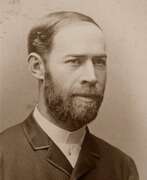

Heinrich Rudolf Hertz was a German physicist and inventor of radio waves.
Hertz graduated from the University of Berlin, studying under Hermann von Helmholtz and Gustav Kirchhoff, then was a professor of physics at the University of Karlsruhe, and from 1889 became a professor of physics at the University of Bonn.
A tireless experimenter, Hertz conducted various experiments with electric waves. Hertz reported his first discovery at the end of 1887 in a treatise "On the electromagnetic effects caused by electrical perturbations in insulators," which he sent to the Berlin Academy. For a time the waves he discovered were called Hertzian waves, but today they are known as radio waves. Hertz's discovery was a confirmation of James Clerk Maxwell's electromagnetic theory and paved the way for numerous advances in communication technology.
Hertz is also known for the discovery of the photoelectric effect, which occurred during his research on electromagnetic waves. Hertz was only 37 years old at the time of his death and many of his experiments and work remained unfinished, but his discovery of radio waves had a huge impact on the world in the 20th century, paving the way for the development of radio, television and radar.
